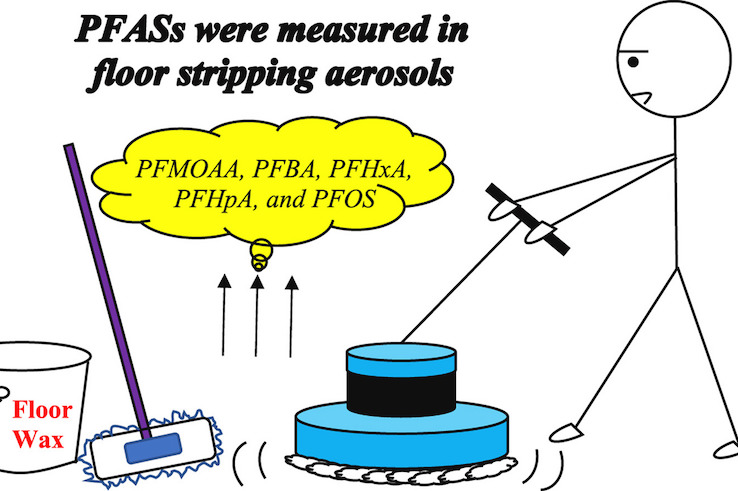Floor waxing could be an important source of PFAS contamination, with increased occupational health risks for workers
May 25, 2022
There’s a special satisfaction that comes from walking on perfectly shined floors — but is it worth the potential risk to floor waxing workers?
A study published earlier this year measured per- and polyfluoroalkyl substances (PFAS) in dust and airborne particulate matter during professional floor stripping and waxing. After estimating PFAS emission rates generated from the process, researchers concluded that significantly higher levels of PFAS were present during floor waxing.

This graphical abstract was published in Atmospheric Environment.
The study was led by Jiaqi Zhou, PhD, a postdoctoral researcher in the Department of Environmental Sciences and Engineering at the UNC-Chapel Hill Gillings School of Global Public Health. Collaborators include Karsten Baumann; Naomi Chang; Glenn Morrison; Wanda Bodnar; Zhenfa Zhang; Jason Surratt; and Barbara J. Turpin — all with the Gillings School — and Joanna M. Atkin, with UNC’s Department of Chemistry.
PFAS are human-produced chemicals commonly used in industry and consumer products. Most PFAS do not break down over time, so they remain in the environment and in the bodies of exposed human and animals long after initial use. Scientific studies have shown that exposure to PFAS may be linked to harmful health effects, which was the impetus for this study.
Published in Atmospheric Environment, the paper reports that floor waxing floor waxing workers could have increased occupational health risks due to PFAS exposures.
“Assessment of occupational exposure due to floor maintenance is important because PFAS exposures can lead to increased risk of cancer, immunotoxicity and neurodevelopmental problems,” the co-authors write.
Based on the findings of their pilot study, they recommend further investigation of PFAs exposure in both home and commercial floor waxing settings, with a focus on evaluating potential exposure mitigation measures.
“This is the first paper to raise awareness of the potential for PFAS exposures to workers in these occupations,” said Professor Barbara J. Turpin, PhD, Zhou’s postdoctoral adviser and the chair of the Gillings School’s Department of Environmental Sciences and Engineering. “It is also an example of how engineering tools, like the principles of mass balance, and chemistry resources, like UNC’s Mass Spectrometry Core Laboratory, can be used to address public health problems.”
Contact the UNC Gillings School of Global Public Health communications team at sphcomm@unc.edu.
